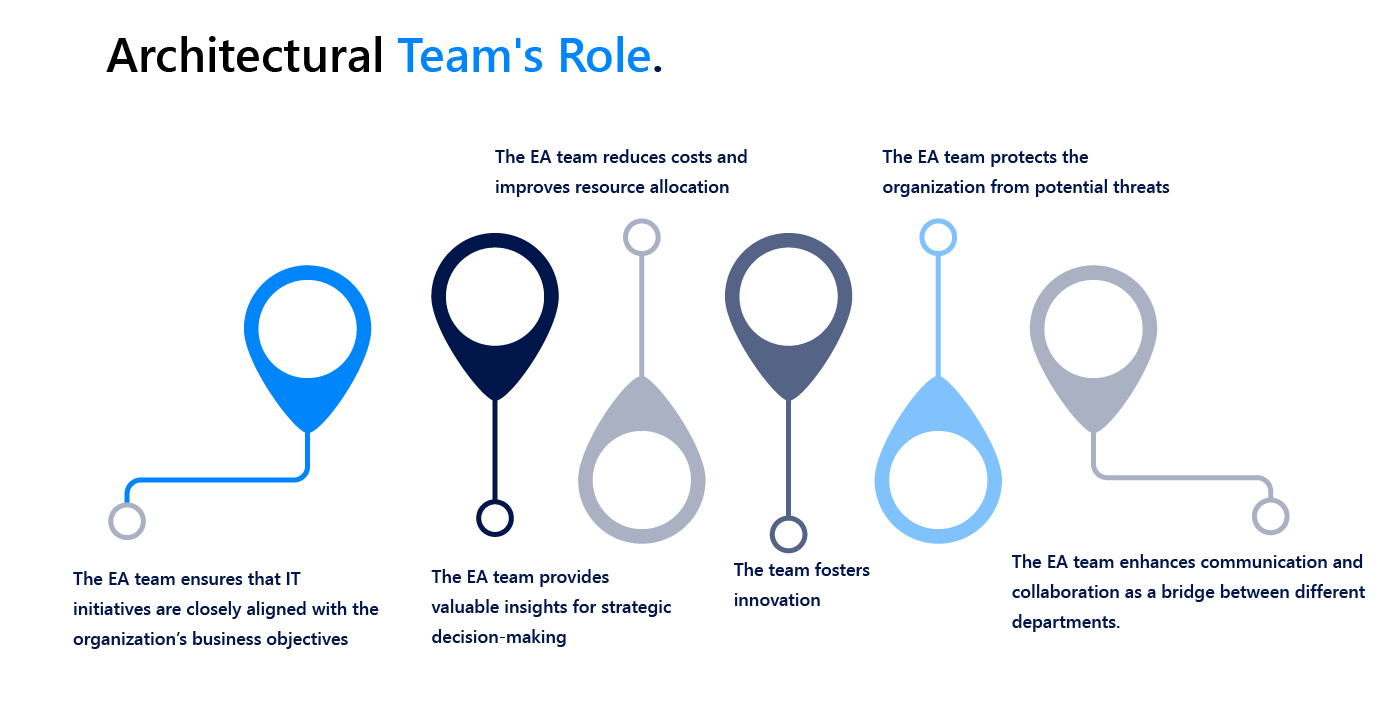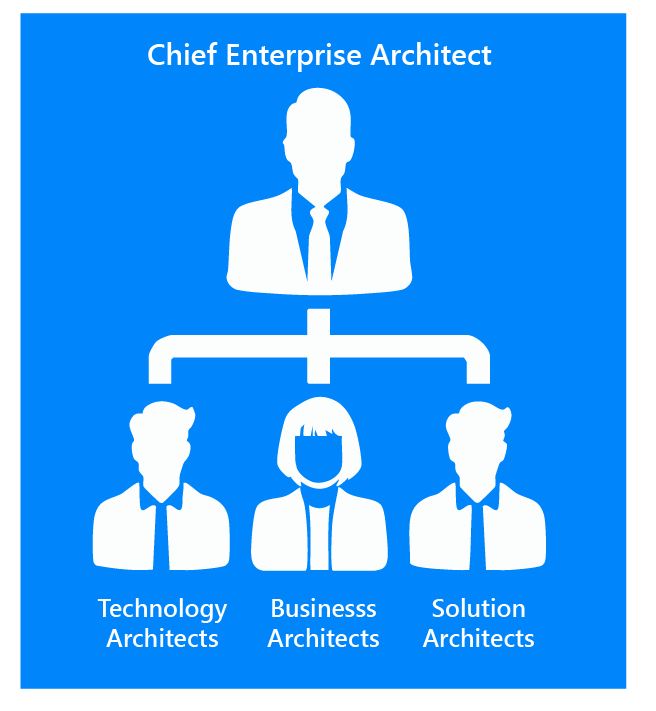Enterprise Architecture Team: Key Roles and Responsibilities

Enterprise architecture teams play a crucial role in shaping organizations' technological landscapes. Comprised of skilled professionals with a deep understanding of business and technology domains, these teams ensure that the IT infrastructure aligns with the company's overall goals and objectives.
A robust enterprise architecture team is crucial for organizations looking to stay competitive and adaptable. Discover the critical aspects of creating and managing an effective enterprise architecture team to drive digital transformation and organizational success.
What is Enterprise Architecture and its Role in Organizations?
Enterprise architecture (EA) is a blueprint for organizing and aligning an organization's architecture and design to achieve its business outcomes. It encompasses various domains such as technology, business processes, and information systems, providing a holistic view of the organization.
Enterprise architects translate business needs into actionable architecture and design solutions. They collaborate with stakeholders, lead agile teams, and develop architecture roadmaps that guide the organization toward its goals.
Architect Role in Enterprise Architecture Teams
Distinguishing Between Enterprise Architect and Solution Architect: While enterprise architects focus on aligning business and technology strategies, solution architects concentrate on designing specific solutions to address business challenges. Both roles are crucial for achieving overall organizational goals.
Architects are vital in driving digital transformation initiatives by leveraging emerging technologies, defining architectural principles, and implementing frameworks like TOGAF to ensure consistency and scalability.
Frameworks such as TOGAF provide a structured approach to enterprise architecture development, guiding architects in creating comprehensive solutions that align with business needs.
Organizational Agility and the Enterprise Architecture Team
To support organizational agility, the EA team must adapt quickly to changing business requirements, collaborate closely with stakeholders, and provide architecture roadmaps that facilitate operational success.
Engaging stakeholders and understanding their needs is essential for delivering architecture solutions that address critical business challenges. Effective communication and collaboration with stakeholders enhance the relevance and impact of the EA team's efforts.
Enterprise architects must develop clear roadmaps that outline the organization's strategic direction and provide a roadmap for implementing architecture and design changes to drive operational success.
Roles and Responsibilities of an Enterprise Architecture Team
Building an enterprise architecture team within an organization is essential for ensuring the alignment of IT and business strategies. The chief enterprise architect guides the team in their architecture roles and supports the organization's enterprise architecture work. This team may include agile solution architects, solution delivery teams, and a service team collaborating across the organization to support the business domain and line of business.
Primary Responsibilities of the EA Team
One of the critical responsibilities of an enterprise architecture team is to establish a collaborative EA team structure that can effectively respond to the organization's needs. The team may receive requests for the EA team to provide insights on how the organization's architecture work can support the benefit of the enterprise. The reporting structure and the organization's enterprise architecture should be designed to facilitate communication and collaboration.
Enterprise Architecture Team Structure
An EA team should be structured to facilitate quick decision-making and seamless collaboration. A successful EA team structure includes delivery teams focused on specific value streams, an architecture owner responsible for overarching decisions, and business architects who align business objectives with business processes.
| Architecture team structure
|
The enterprise architecture team also plays a crucial role in defining the structure of the organization's IT systems and ensuring they align with the overall business strategy. This involves working closely with various stakeholders, including senior management and other solution delivery teams, to ensure that the organization's enterprise architecture supports the business's goals and objectives. The team is responsible for providing guidance and expertise on implementing and maintaining the architecture roles across the organization.
|
Importance of Architecture Team in Organizational Structure

- Alignment of IT and Business Goals: The EA team ensures that IT initiatives are closely aligned with the organization's business objectives, leading to more efficient and effective operations.
- Strategic Decision-Making: With a deep understanding of business and technology, the EA team provides valuable insights for strategic decision-making, helping the organization invest in the right technologies.
- Cost Efficiency: The EA team reduces costs and improves resource allocation by optimizing the IT infrastructure and eliminating redundancies.
- Innovation and Agility: The team fosters innovation by identifying and integrating new technologies to drive business growth and enable the organization to respond quickly to market changes.
- Risk Reduction: The EA team protects the organization from potential threats and ensures business continuity through effective risk management and compliance practices.
- Improved Collaboration: The EA team enhances communication and collaboration as a bridge between different departments, leading to better project outcomes and a more cohesive work environment.
Analyzing EA Team Structures Through Reporting Metrics
The structure of an Enterprise Architecture (EA) team can vary based on how it integrates within the organization's reporting hierarchy. Different structures offer unique advantages and can influence the effectiveness and alignment of the EA team with business objectives. Here are some common EA team structures based on reporting:
Centralized EA Team
In a centralized structure, the EA team reports directly to a top-level executive, typically the Chief Information Officer (CIO) or Chief Technology Officer (CTO). This model offers several benefits:
- Unified Vision: A centralized team ensures a cohesive and unified vision for the enterprise architecture across the entire organization.
- Standardization: It promotes standardization of processes, technologies, and governance practices, reducing redundancy and ensuring consistency.
- Strategic Alignment: Direct reporting to top executives facilitates better alignment of IT strategy with overall business goals.
- Resource Optimization: Centralized management of resources can lead to more efficient allocation and utilization of IT assets.
Decentralized EA Team
EA team members are embedded within different business units or departments in a decentralized structure. They report to their respective department heads but maintain a dotted-line relationship with a central EA function. This model offers the following advantages:
- Business Unit Alignment: EA team members closely understand and align with individual business units' needs and goals.
- Agility: This structure allows for more flexibility and quicker response times to address each department's unique challenges and opportunities.
- Enhanced Collaboration: Embedded architects foster stronger collaboration and communication between the IT function and business units.
Federated EA Team
A federated structure combines elements of both centralized and decentralized models. The EA team operates as a central authority but has representatives or liaisons within various business units. These liaisons report to their respective business units and have a dotted-line reporting relationship to the central EA function. The federated model provides:
- Balanced Governance: It strikes a balance between centralized control and decentralized agility, allowing for both standardization and flexibility.
- Cross-Functional Collaboration: The federated model encourages cross-functional collaboration and knowledge sharing between the central EA team and business units.
- Local Adaptation: It allows for the adaptation of enterprise architecture principles to meet local business needs while maintaining overall strategic alignment.
Matrix EA Team
In a matrix structure, EA team members have dual reporting lines, one to the central EA function and another to their respective business units or projects. This model offers:
- Dual Focus: Team members can focus on enterprise-wide standards and specific business unit needs, ensuring comprehensive coverage of architectural concerns.
- Resource Sharing: The matrix structure facilitates efficient resource sharing and utilization across different projects and business units.
- Enhanced Communication: It fosters improved communication and coordination between central EA governance and individual business units, leading to better integration and execution of EA initiatives.
| Choosing the right EA team structure depends on the organization's size, complexity, and strategic goals. Each structure offers unique benefits and challenges, and the decision should align with the organization's specific needs and culture. Regardless of its reporting hierarchy, a well-structured EA team ensures that the IT architecture effectively supports the business strategy and drives overall organizational success. ensures |
EA Team Structures with Project Management Principles
Different project management structures offer distinct benefits and can impact how well the EA team aligns with business goals, adapts to changes, and delivers value. Here are some common EA team structures based on project management:
Project-Centric EA Team
In a project-centric structure, the EA team is organized around specific projects. Each project has a dedicated team of architects who focus on the project from inception to completion. This model offers several benefits:
- Focused Expertise: Architects develop deep project expertise, leading to higher-quality outcomes.
- Clear Accountability: With dedicated teams, accountability is clear, and performance can be easily tracked.
- Flexibility: Teams can be dynamically formed and disbanded based on project needs, allowing for flexibility in resource allocation.
Program-Centric EA Team
In a program-centric structure, the EA team is organized around broader programs that encompass multiple related projects. This structure ensures that related projects are aligned and managed cohesively. The advantages include:
- Strategic Alignment: Ensures that all projects within a program align with the overarching business strategy and architectural principles.
- Resource Efficiency: Resources can be shared across projects within a program, improving efficiency and reducing redundancy.
- Integrated Outcomes: Encourages integration and synergy between related projects, leading to more comprehensive and effective solutions.
Agile EA Team
An Agile EA team structure adopts agile principles and practices, focusing on iterative development, collaboration, and flexibility. Teams are typically cross-functional and self-organizing. The benefits include:
- Adaptability: The team can quickly respond to changing business needs and priorities, ensuring the architecture evolves as required.
- Continuous Delivery: Agile practices promote constant value delivery through incremental updates and improvements.
- Enhanced Collaboration: Agile methodologies foster close collaboration between architects, developers, and business stakeholders.
Center of Excellence (CoE) EA Team
In a CoE structure, the EA team operates as a central hub of expertise and best practices. This team provides guidance, standards, and support to project teams across the organization. The advantages include:
- Consistency and Standards: Ensures all projects adhere to enterprise-wide architectural standards and best practices.
- Knowledge Sharing: Facilitates the sharing of knowledge, tools, and techniques across projects, promoting continuous improvement.
- Support and Guidance: Provides expert support and guidance to project teams, enhancing the quality and success of individual projects.
Best Practices for Building a Successful Enterprise Architecture Team
Establishing effective operating models ensures the EA team functions cohesively and efficiently, aligning its activities with organizational goals and objectives.
Embracing agile methodologies allows architecture teams to adapt quickly to changing requirements, iterate on solutions, and promptly deliver value to the organization.
Building a culture of collaboration and continuous improvement within the EA team promotes innovation, knowledge sharing, and a shared commitment to driving successful enterprise architecture initiatives.
Summary
The Enterprise Architecture (EA) team is composed of key roles such as Enterprise Architects, Solution Architects, Business Architects, and Technology experts; their primary mission is to ensure the alignment of an organization's IT infrastructure with its business objectives.
Different organizational structures, including centralized, decentralized, federated, and matrix setups, cater to various strategic needs, fostering agility, innovation, and collaboration. To enhance effectiveness, the team must adopt agile methodologies and nurture a culture of continuous improvement, which is crucial for driving digital transformation and organizational success.




